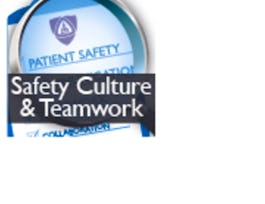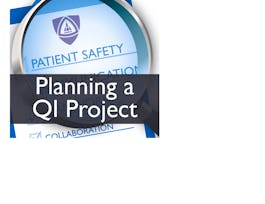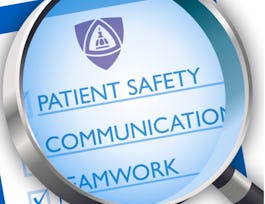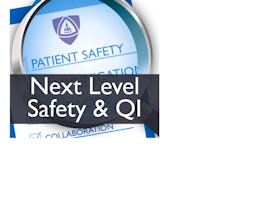In this course, you will be able develop a systems view for patient safety and quality improvement in healthcare. By then end of this course, you will be able to: 1) Describe a minimum of four key events in the history of patient safety and quality improvement, 2) define the key characteristics of high reliability organizations, and 3) explain the benefits of having strategies for both proactive and reactive systems thinking.


Patient Safety and Quality Improvement: Developing a Systems View (Patient Safety I)
This course is part of Patient Safety Specialization
Taught in English
Some content may not be translated

Instructor: Melinda Sawyer
30,796 already enrolled
Included with 
Course
(1,416 reviews)
96%
Recommended experience
What you'll learn
Describe a minimum of four key events in the history of patient safety and quality improvement.
Define the key characteristics of high reliability organizations.
Explain the benefits of having strategies for both proactive and reactive systems thinking.
Skills you'll gain
Details to know

Add to your LinkedIn profile
4 quizzes
Course
(1,416 reviews)
96%
Recommended experience
See how employees at top companies are mastering in-demand skills

Build your subject-matter expertise
- Learn new concepts from industry experts
- Gain a foundational understanding of a subject or tool
- Develop job-relevant skills with hands-on projects
- Earn a shareable career certificate


Earn a career certificate
Add this credential to your LinkedIn profile, resume, or CV
Share it on social media and in your performance review

There are 4 modules in this course
In this module, you will review the history of patient safety and quality improvement in healthcare. You will start with defining the scope of the problem of preventable harm in healthcare which leads into the history of the work that has been done to date that has helped to define, measure and improve preventable harm. You review three landmark reports to ensure you have a deep understanding of this work. At the end of this module, you will be able to: 1) identify a minimum of four key events in the history of patient safety an quality improvement, 2) describe the key characteristics of each of the three landmark patient safety publications and 3) summarize the impact of preventable harm on patients, communities and society.
What's included
7 videos5 readings1 quiz
In this module, you will be reviewing several key terms and tools that are used in patient safety and quality improvement. This will allow you to begin to develop the common language used among patient safety and quality improvement experts and practitioners. By the end of this module you will be able to: 1) differentiate between the terms harm, hazard, error and risk within a patient safety and quality improvement framework, 2) describe how quality and safety overlap and how they are different and 3) differentiate between root cause analysis and a failure mode and effects analysis.
What's included
11 videos1 quiz
In this module, you will learn the fundamental principles of high reliability organizing. At the end of this lesson, you will also be able to: 1) describe the socio-cultural characteristics of high reliability organizations (HROs), 2) compare and contrast healthcare with high reliability organizations and 3) identify three improvement tools for high reliability organizing.
What's included
7 videos1 quiz
In this module, you will learn the basics of systems thinking and then apply these to a healthcare setting. At the end of this module, you will be able to 1) explain the basic components of a system, 2) differentiate first order problem solving and second order problem solving, 3) explain the benefits of having strategies for both proactive and reactive systems thinking.
What's included
9 videos1 quiz
Instructor

Offered by
Recommended if you're interested in Healthcare Management

Johns Hopkins University

Johns Hopkins University

Johns Hopkins University

Johns Hopkins University
Why people choose Coursera for their career




Learner reviews
Showing 3 of 1416
1,416 reviews
- 5 stars
84.95%
- 4 stars
13.48%
- 3 stars
1.12%
- 2 stars
0.21%
- 1 star
0.21%
New to Healthcare Management? Start here.

Open new doors with Coursera Plus
Unlimited access to 7,000+ world-class courses, hands-on projects, and job-ready certificate programs - all included in your subscription
Advance your career with an online degree
Earn a degree from world-class universities - 100% online
Join over 3,400 global companies that choose Coursera for Business
Upskill your employees to excel in the digital economy
Frequently asked questions
Access to lectures and assignments depends on your type of enrollment. If you take a course in audit mode, you will be able to see most course materials for free. To access graded assignments and to earn a Certificate, you will need to purchase the Certificate experience, during or after your audit. If you don't see the audit option:
The course may not offer an audit option. You can try a Free Trial instead, or apply for Financial Aid.
The course may offer 'Full Course, No Certificate' instead. This option lets you see all course materials, submit required assessments, and get a final grade. This also means that you will not be able to purchase a Certificate experience.
When you enroll in the course, you get access to all of the courses in the Specialization, and you earn a certificate when you complete the work. Your electronic Certificate will be added to your Accomplishments page - from there, you can print your Certificate or add it to your LinkedIn profile. If you only want to read and view the course content, you can audit the course for free.
If you subscribed, you get a 7-day free trial during which you can cancel at no penalty. After that, we don’t give refunds, but you can cancel your subscription at any time. See our full refund policy.

